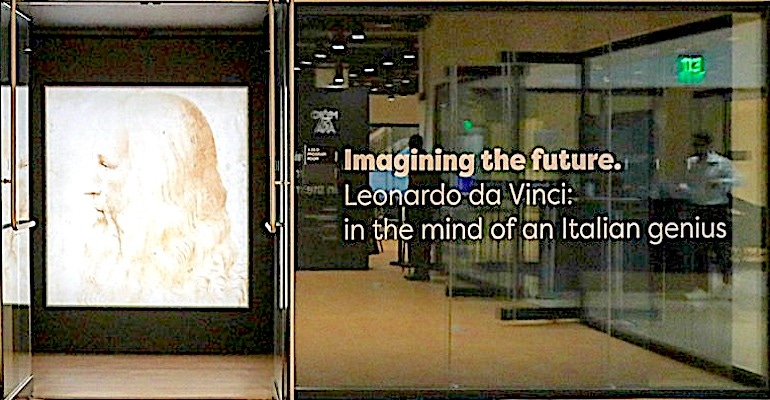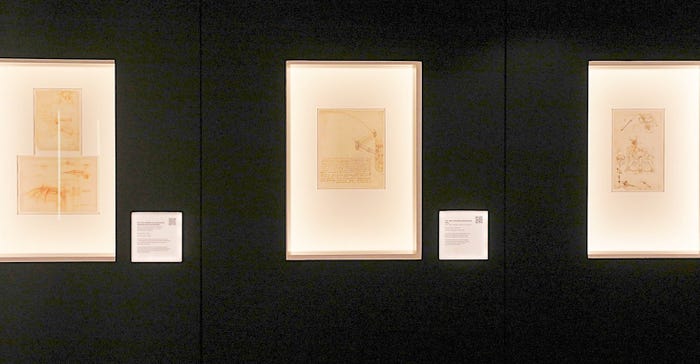Da Vinci's 'Codex Atlanticus' Inventions' First U.S. Exhibition
This is the first time that the imaginative drawings in Leonardo Da Vinci's Codex Atlanticus have been displayed in the U.S. and you can see his inventions in Washington, D.C.

Italian Renaissance polymath Leonardo da Vinci exists now as a nearly mythical figure, with accomplishments in painting, sculpting, architecture, and engineering that make him seem almost fictional today.
However, anyone who can get to Washington, D.C. by August 20 can see some of his work with their own eyes at the District of Columbia Martin Luther King Jr. Memorial Library rather than fighting the mobs at The Louvre to see his Mona Lisa.
Rather than his celebrating paintings, such as the enigmatic portrait of Mona Lisa and Da Vinci’s depiction of Jesus’s Last Supper, the DC Public Library is showing technical drawings from the Codex Atlanticus that should appeal to engineers and anyone with technical curiosity.
The codex’s 12-volume collection of more than 1,200 pages covers subjects ranging from flight to weaponry to mathematics to botany, with inspirational practical applications in fields such as engineering and design.
Drawings and designs in the codex were created between 1478 and 1519 but they reveal Da Vinci designs for and inventions of devices such as a flying machine and an armored vehicle.
Consider some of these innovative designs that will be on display:
Study for a digging machine:The study consists of a detailed drawing depicting a large device with a rotating mechanism. It includes gears for motion transmission and a mechanical arm with a bucket-like attachment designed for scooping and removing earth or debris.
Medium: Black chalk, pen and ink, watercolor on dark prepared paper
Dimensions: Approximately 23 cm x 39.2 cm
Date: Around 1503-1504
Medium: Black chalk, pen and ink, watercolor on dark prepared paper
Dimensions: Approximately 27 cm x 40 cm
Date: Around 1503-1505
Study of the current of a river and drawing of a mechanical wing: This study involves sketches and observations of river currents, documenting flow patterns, eddies, and the behavior of water in rivers. Detailed diagrams illustrate the movement and interaction of water, demonstrating Leonardo's scientific exploration of hydrodynamics.
Current of a River
Medium: Red pencil on paper
Dimensions: Approximately 19.8 cm x 14.1 cm
Date: Unknown
Drawing of a mechanical wing
Medium: Red pencil on paper
Dimensions: Approximately 18.1 cm x 24.7 cm
Date: Around 1490
Perpetual motion study and architectural studies: The perpetual motion study explores the concept of continuous motion without an external energy source, featuring sketches and notes of mechanisms. The architectural studies comprise drawings and plans showcasing imaginative and innovative designs for structures and spatial arrangements.
Medium: Drypoint, pen and pencil on paper
Dimensions: Approximately 34.3 cm x 24.5 cm
Date: Around 1503-1505
Studies of geometric proportions: These studies involve detailed diagrams and calculations exploring mathematical principles applied to art and architecture. The golden ratio and harmonious proportions are analyzed and incorporated into Leonardo's artworks and architectural designs.
Medium: Pencil and ink on paper
Dimensions: Approximately 21 cm x 28 cm
Date: Around 1478-1480,
Study of self-propelling cart: This study consists of sketches and designs for a cart capable of self-propulsion. The drawings depict mechanisms and gears enabling the cart to move without external assistance, reflecting Leonardo's curiosity about self-propulsion.
Medium: Pen and ink on paper
Dimensions: Approximately 27 cm x 16.9 cm
Date: Around 1478
Study of a mechanical wing: The study includes detailed drawings exploring wing designs for potential flying machines. These sketches depict various wing structures and mechanisms, reflecting Leonardo's interest in aerodynamics and flight.
Medium: Pen and ink on paper
Dimensions: Approximately 26.7 cm x 21.6 cm
Date: Around 1505-1506
Revolving crane with adjustable counterweight: The drawing showcases a detailed design for a crane mechanism with a rotating arm and an adjustable counterweight, ensuring balance and stability during lifting and movement.
Medium: Pen and ink on paper
Dimensions: Approximately 31.5 cm x 20 cm
Date: Around 1478-1480
Diving apparatus and water pumping devices: These sketches depict concepts for diving machines and water pumps, showcasing Leonardo's designs for underwater exploration and water transport mechanisms.
Medium: Metal point marks, pen and ink on paper
Dimensions: Approximately 28.5 cm x 39.7 cm
Date: Around 1480-1482
Study of hydraulic pump and fountain within an architecture: The study presents sketches of hydraulic mechanisms for water pumping and fountains integrated into architectural structures. The drawings illustrate the hydraulic pump's components and workings and the fountain's placement within the architectural context.
Medium: Pen and ink, watercolors on paper
Dimensions: Approximately 37.5 cm x 17.3 cm
Date: Around 1500
Cloth shearing machine: The drawing depicts a mechanical device designed to automate cutting or shearing cloth. Detailed sketches showcase the arrangement of blades and mechanisms for efficient and precise cloth shearing.
Medium: Pen and ink over traces of black chalk on paper
Dimensions: Approximately 28.5 cm x 40.8 cm
Date: Around 1495
Study of ventilators and map of the central-eastern Mediterranean: The study involves sketches and designs exploring ventilation systems and mechanisms. The map represents Leonardo's cartographic work, providing a detailed depiction of the central-eastern Mediterranean region, including coastlines, geographical features, and place names.
Medium: Ink on paper
Dimensions: Approximately 24.6 cm x 33.2 cm
Date: Around 1497-1499

Some of these creations were practical designs for objects that could be built and function as intended, while others such as the mechanical wing were aspirational and needed the development of additional technology to be practical. Alas, his perpetual motion study remains out of reach.
The exhibition runs until Aug. 20. Entry is first-come, first-served, with a limit of 15 guests at a time. For those who are unable to attend, there are online resources to experience the Codex Atlanticus.
Explore the Codex
In 2019, Biblioteca Ambrosiana and The Visual Agency partnered to create an interactive website that organized the Codex’s 1,119 pages by subject, year, and page number, allowing exploration of the Codex Atlanticus in its entirety.
Library Resources Related to the Codex Atlanticus
"Leonardo's Lab" is an interactive exhibition designed for families and children to explore the life and work of Leonardo da Vinci, the original Renaissance man. Developed by the Carnegie Science Center and produced in partnership with Sciencenter, this exhibit offers a unique, hands-on learning experience that delves into da Vinci's numerous accomplishments across various disciplines, such as art, science, engineering, and mathematics.
About the Author(s)
You May Also Like





